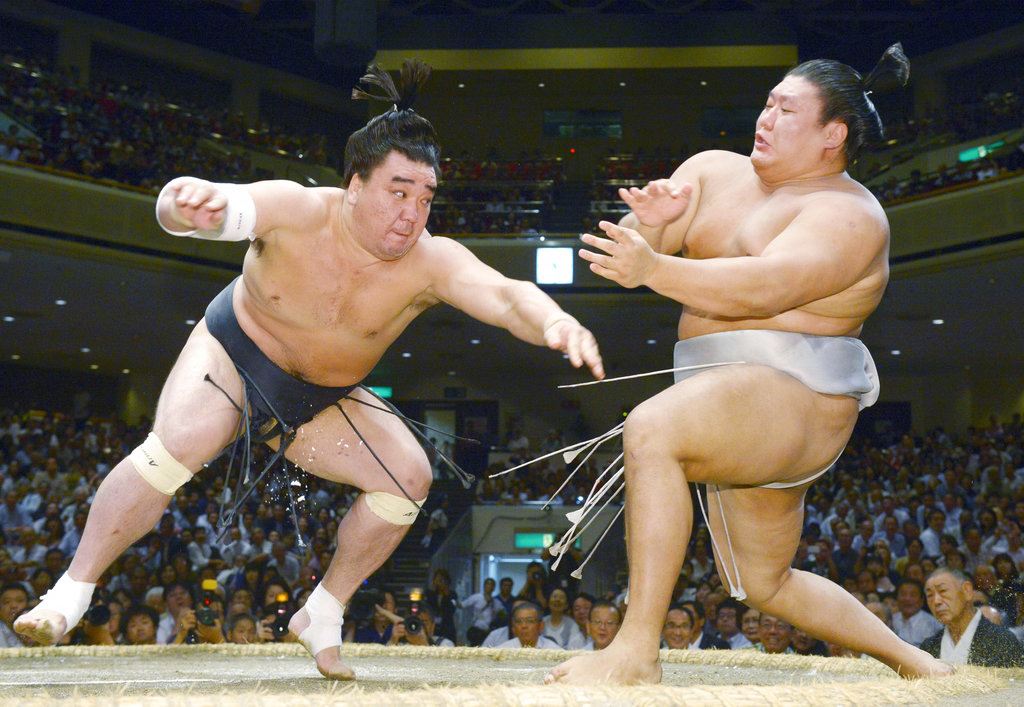
FILE – In this Sept. 16, 2017, file photo, then Mongolian sumo grand champion Harumafuji, left, pushes opponent Takanoiwa out of the ring to win their bout at the Autumn Grand Sumo Tournament in Tokyo. Takanoiwa, who fractured his skull in an altercation with former grand champion Harumafuji in a restaurant October 2017, is hoping to make a comeback at the March 11-25 Osaka tournament. (Kyodo News via AP)
TOKYO — The most damage inflicted in sumo in recent times has been to the image of Japan’s tradition-steeped national sport.
An alcohol-fueled restaurant brawl that left a Mongolian wrestler with a fractured skull and a sexual assault scandal involving the sport’s highest-ranked referee have rocked the sport in recent months. Those episodes followed a match-fixing investigation in 2011 and the death of a teenage wrestler in training in 2007 that have tainted sumo over the last decade.
Organizers are hoping to restore its battered reputation when the Spring Grand Sumo tournament starts on the weekend.
Takanoiwa, who fractured his skull in an altercation with former Grand Champion Harumafuji in a restaurant last October, is hoping to make a comeback at the Osaka event.
“I’m just focusing on doing my best,” the 28-year-old Takanoiwa told reporters last week during a training session for the tournament. “It will take a bit more time to be ready.”
A healthy Takanoiwa wouldn’t solve all sumo’s problems but would be a big step in the road to recovery.
He was hurt after a group of Mongolian wrestlers had assembled at a restaurant during a regional tour.
Harumafuji was reported to have become aggravated when Takanoiwa repeatedly checked his mobile phone while the two were conversing.
In addition to Harumafuji, who was forced to retire last November in the wake of the incident, Grand champion Hakuho was also present and had to defend his inability to intervene before the situation got out of control.
The altercation dominated news programs and headlines for weeks. Adding to the bad publicity, the sport’s top-ranked referee was forced to resign earlier this year over a sexual harassment scandal.
Shikimori Inosuke apologized to the Japan Sumo Association for allegedly kissing a teenage referee and touching him on the chest while intoxicated during a regional tour of Okinawa in December.
Inosuke said he had no recollection of the incident, and the junior referee declined to file charges.
In the wake of the scandal, though, Emperor Akihito and Empress Michiko didn’t attend January’s New Year tournament for the first time in four years.
Weeks after that, Egyptian wrestler Osunaarashi was caught driving without a license after a vehicle collision and was ordered to pay a $4,700 fine.
The recent incidents are just the latest scandals to rock the sumo world.
In 2011, the JSA decided to cancel the Spring tournament after revelations that 14 wrestlers were involved with match-fixing.
In 2010, grand champion Asashoryu, also of Mongolia, announced his retirement following reports that he injured a man while intoxicated.
In the most troubling case in 2007, the 17-year-old wrestler Takashi Saito died when he was beaten over the head with a beer bottle at the direction of his trainer.
Saito’s stable master Junichi Yamamoto and three wrestlers were subsequently arrested and charged with manslaughter. In May 2009, Yamamoto was sentenced to six years in prison.
The incident brought substantial political pressure to the governance of the sport in Japan.
In response to the latest scandals this year, the Japan Sumo Association announced that a third-party committee has been convened and will question every member of the JSA. About 900 people, including active wrestlers and elders, will be included in the inquiry.
“Our goal is the preservation of sumo,” committee chairman Keiichi Tadaki, a former prosecutor general, said.